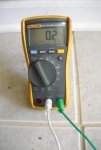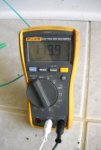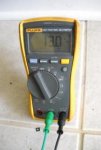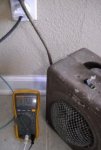MAC702
Senior Member
- Location
- Clark County, NV
...These devices are not intended for use as comprehensive diagnostic instruments...
Except for certified home inspectors.
...These devices are not intended for use as comprehensive diagnostic instruments...
Except for certified home inspectors.
Yep. They are notoriously bad at detecting bootleg grounds.Just a thought about those plug-in testers
You mean 'Graduates of the Class of Tuesday, 10:30 AM"?
I'm going to steal that one! :lol:





So ... finally made it back to the site.
I'm revising my estimate of the age of this house -- now 1946-1959 -- after noticing 2-wire cloth-jacketed NM cable and black-enameled junction/device boxes.
The circuit in question is in the breakfast nook, which is a later addition. There are four ordinary 5-15R receptacles and a ceiling light on a 15-amp breaker. The Sperry plug-in tester shows the same HOT/NEU REV fault indication in all four receptacles.
I pulled the two receptacles nearest to and farthest from the breaker panel. They're wired with yellow plastic-jacketed NM cable. The bare wires are wire-nutted together, with stubs to the receptacles' ground terminals. The black & white wires are screwed to the receptacles -- no backstabbing -- are on the correct terminals, use the receptacles themselves to provide continuity, and are clean & tight. No surprises; good-quality work.
Using the low-impedance meter function yielded different measurements but no additional insight. Likewise putting the circuit under load.
Unloaded, the circuit voltage was a trifle below nominal. With a ten-ohm (?) load, there was an unsurprising and totally-acceptable amount of voltage drop.
But the goofy thing: 13 volts between green & black. In Lo-Z mode, so it's apparently not a phantom voltage, and unchanged by loading the circuit.
The other goofy thing: When the Fluke 117 was in the circuit in Lo-Z mode, the Sperry tester began flashing between "HOT/NEU REV" and "BAD GROUND". Seemingly at random, at about 3 Hz, and nowhere near a 50% duty cycle.
- - -
This circuit's breaker feeds a 2-wire cloth-covered NM cable, which disappears into a first-floor wall cavity immediately above the breaker box. Thirty feet east, the receptacles are connected with 3-wire plastic-jacketed NM cable. I was unable to locate a junction box -- if there is one -- where the two meet.
So as far as the house wiring goes, mystery solved.
The only remaining mystery: Why the goofy instrument indications.
How do you figure that the mystery is solved regarding the house wiring?So as far as the house wiring goes, mystery solved.
The instrument readings are goofy because the wiring is goofy. I bet if you were to measure the resistance between the ground terminal of that outlet and the ground bus in the distribution panel, you'll find get a reading of about ~24,000Ω.The only remaining mystery: Why the goofy instrument indications?
I'd be looking for my>>>>

~RJ~
We have been talking about this for what, four days? And we have yet to pull the receptacle to look at the wiring and the connections.
Wow.
QRZ? de W4KAV
Amateurs! :roll:D)
How do you figure that the mystery is solved regarding the house wiring?
The instrument readings are goofy because the wiring is goofy. I bet if you were to measure the resistance between the ground terminal of that outlet and the ground bus in the distribution panel, you'll find get a reading of about ~24,000Ω.
You need to find where the 2-wire cloth jacketed NM joins the 3-wire Romex. I bet you'll find a bad ground there.
The branch circuit in question almost assuredly has a high-resistance ground. In my book, that's something in the electrical system that's "not working" and requires troubleshooting and correction.I am not sure what the problem we are trying to solve actually is. I may have missed that somewhere.
Is there a light not working or a receptacle that won't power up a device somewhere? I saw all the voltage measurements. What exactly would an electrician be troubleshooting? What is not working?
This circuit's breaker feeds a 2-wire cloth-covered NM cable, which disappears into a first-floor wall cavity immediately above the breaker box. Thirty feet east, the receptacles are connected with 3-wire plastic-jacketed NM cable. I was unable to locate a junction box -- if there is one -- where the two meet.
I am not sure what the problem we are trying to solve actually is. I may have missed that somewhere.
Is there a light not working or a receptacle that won't power up a device somewhere? I saw all the voltage measurements. What exactly would an electrician be troubleshooting? What is not working?
The branch circuit in question almost assuredly has a high-resistance ground. In my book, that's something in the electrical system that's "not working" and requires troubleshooting and correction.
I agree. Which is why I stated (as did you) that he needs to find where the old 2-wire NM meets up with the new 2+G NM. I'm guessing that whoever did the wiring for the addition made some kind of ground connection at that junction and it has either become a bad connection, or the source of the ground was poor to begin with.In this case we have no idea where they are even connecting to any sort of ground.

